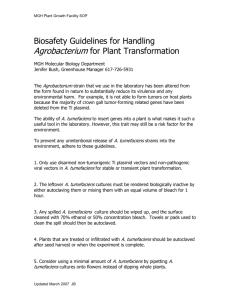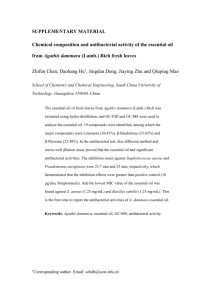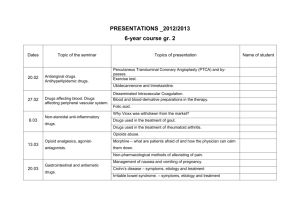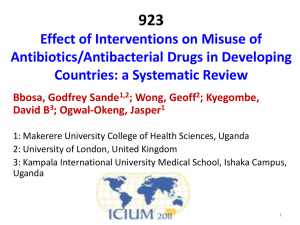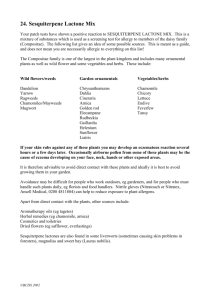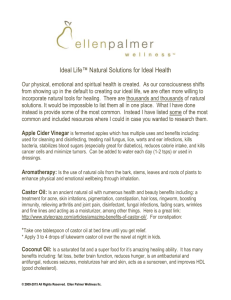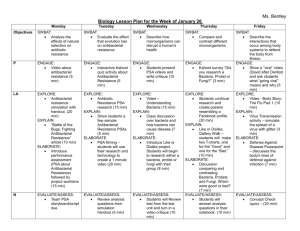Antibacterial and Biochemical Activity of Pseudoguaianolide
advertisement
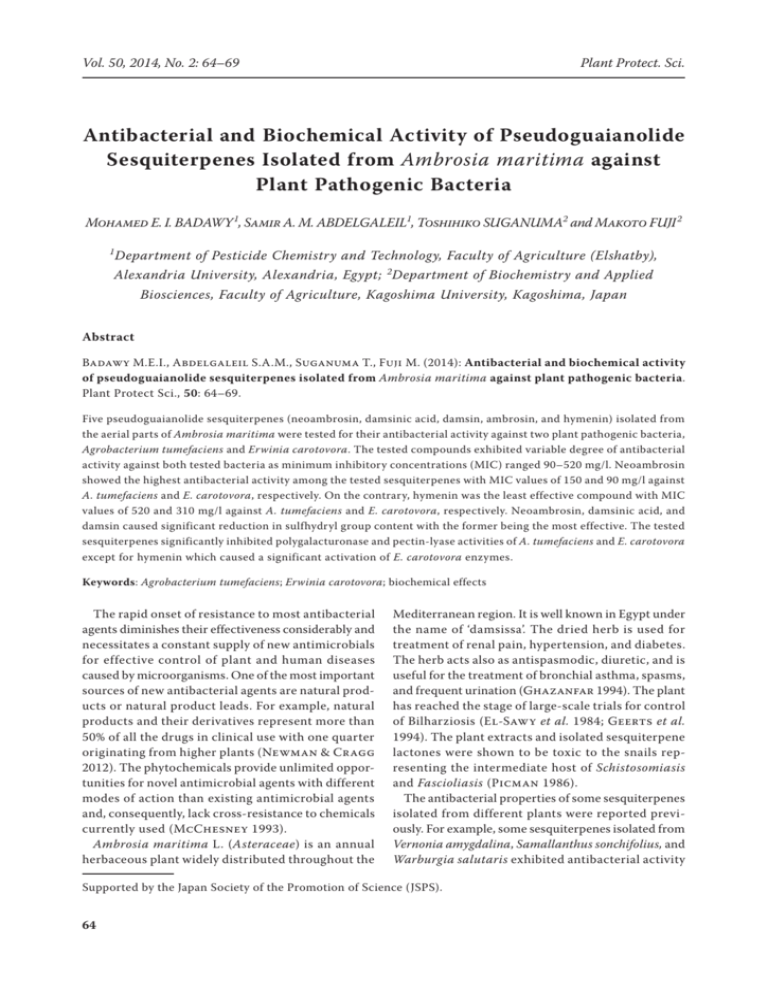
Vol. 50, 2014, No. 2: 64–69 Plant Protect. Sci. Antibacterial and Biochemical Activity of Pseudoguaianolide Sesquiterpenes Isolated from Ambrosia maritima against Plant Pathogenic Bacteria Mohamed E. I. Badawy 1, Samir A. M. Abdelgaleil1, Toshihiko Suganuma2 and Makoto Fuji 2 1 Department of Pesticide Chemistry and Technology, Faculty of Agriculture (Elshatby), Alexandria University, Alexandria, Egypt; 2Department of Biochemistry and Applied Biosciences, Faculty of Agriculture, Kagoshima University, Kagoshima, Japan Abstract Badawy M.E.I., Abdelgaleil S.A.M., Suganuma T., Fuji M. (2014): Antibacterial and biochemical activity of pseudoguaianolide sesquiterpenes isolated from Ambrosia maritima against plant pathogenic bacteria. Plant Protect Sci., 50: 64–69. Five pseudoguaianolide sesquiterpenes (neoambrosin, damsinic acid, damsin, ambrosin, and hymenin) isolated from the aerial parts of Ambrosia maritima were tested for their antibacterial activity against two plant pathogenic bacteria, Agrobacterium tumefaciens and Erwinia carotovora. The tested compounds exhibited variable degree of antibacterial activity against both tested bacteria as minimum inhibitory concentrations (MIC) ranged 90–520 mg/l. Neoambrosin showed the highest antibacterial activity among the tested sesquiterpenes with MIC values of 150 and 90 mg/l against A. tumefaciens and E. carotovora, respectively. On the contrary, hymenin was the least effective compound with MIC values of 520 and 310 mg/l against A. tumefaciens and E. carotovora, respectively. Neoambrosin, damsinic acid, and damsin caused significant reduction in sulfhydryl group content with the former being the most effective. The tested sesquiterpenes significantly inhibited polygalacturonase and pectin-lyase activities of A. tumefaciens and E. carotovora except for hymenin which caused a significant activation of E. carotovora enzymes. Keywords: Agrobacterium tumefaciens; Erwinia carotovora; biochemical effects The rapid onset of resistance to most antibacterial agents diminishes their effectiveness considerably and necessitates a constant supply of new antimicrobials for effective control of plant and human diseases caused by microorganisms. One of the most important sources of new antibacterial agents are natural products or natural product leads. For example, natural products and their derivatives represent more than 50% of all the drugs in clinical use with one quarter originating from higher plants (Newman & Cragg 2012). The phytochemicals provide unlimited opportunities for novel antimicrobial agents with different modes of action than existing antimicrobial agents and, consequently, lack cross-resistance to chemicals currently used (McChesney 1993). Ambrosia maritima L. (Asteraceae) is an annual herbaceous plant widely distributed throughout the Mediterranean region. It is well known in Egypt under the name of ‘damsissa’. The dried herb is used for treatment of renal pain, hypertension, and diabetes. The herb acts also as antispasmodic, diuretic, and is useful for the treatment of bronchial asthma, spasms, and frequent urination (Ghazanfar 1994). The plant has reached the stage of large-scale trials for control of Bilharziosis (El-Sawy et al. 1984; Geerts et al. 1994). The plant extracts and isolated sesquiterpene lactones were shown to be toxic to the snails representing the intermediate host of Schistosomiasis and Fascioliasis (Picman 1986). The antibacterial properties of some sesquiterpenes isolated from different plants were reported previously. For example, some sesquiterpenes isolated from Vernonia amygdalina, Samallanthus sonchifolius, and Warburgia salutaris exhibited antibacterial activity Supported by the Japan Society of the Promotion of Science (JSPS). 64 Plant Protect. Sci. against foodborne bacteria (Rabe & Staden 2000; Lin et al. 2003; Erasto et al. 2006). In our previous studies, the sesquiterpenes isolated from the stem bark of Magnolia grandiflora and aerial parts of Varthemia iphionoides showed potent antibacterial activity against both foodborne and phytopathogenic bacteria (AlDabbas et al. 2005; Abdelgaleil & Ahmed 2008). The sesquiterpenes damsin, ambrosin, and tribromoambrosin isolated from Ambrosia maritima were found to have toxic effect against the freshwater snails Biomphalaria alexandrina and Bulinus truncates (Shoeb & El-Emam 1976). It was also demonstrated that the sesquiterpenes isolated from this plant possessed cytotoxic effect on Chinese hamster’s lung cells (V-79) (Nagaya et al. 1994). Recently, the insecticidal, herbicidal, and molluscicidal activities of some sesquiterpenes isolated from A. maritima have been described (Abdelgaleil 2010). Most of the work on the antimicrobial effects of phytochemicals has been performed on human pathogens, spoilage microorganisms, and dermatophytes, with limited research on phytopathogenic microorganisms. Therefore, the current study was aimed at evaluating the antibacterial activity of sesquiterpenes neoambrosin, damsinic acid, damsin, ambrosin, and hymenin isolated from the aerial parts of A. maritima plant against phytopathogenic bacteria Agrobacterium tumefaciens and Erwinia carotovora. The effects of these five sesquiterpenes on sulfhydryl group contents, and the activities of polygalacturonase and pectin-lyase were also examined to determine the possible modes of action. MATERIAL AND METHODS Chemicals and test bacteria. Thiobarbituric acid and 5,5’-dithio-bis-(2-nitrobenzoic acid) (DTNB) were purchased from Sigma-Aldrich Corporation (St. Louis, USA). All chemicals and solvents were used without further purification. Plant pathogenic bacteria of crown gall disease Agrobacterium tumefaciens (family: Rhizobiaceae; class: Alpha Proteobacteria) and soft mold disease Erwinia carotovora (family: Enterobacteriaceae; class: Gamma Proteobacteria) were provided by Microbiology Laboratory, Department of Plant Pathology, Faculty of Agriculture, Alexandria University, Egypt. The bacterial strains were maintained on nutrient agar medium (NA: peptone 10 g, meat extract 5 g, sodium chloride 2.5 g, and agar 10 g in 1 l distilled water) at 37°C. Extraction and isolation of sesquiterpenes from Ambrosia maritima. The pseudoguaianolide ses Vol. 50, 2014, No. 2: 64–69 14 14 10 2 3 O 1 9 3 8 5 4 10 2 1 15 O 11 12 1 HO 14 3 4 O 10 1 2 9 8 5 6 3 7 15 O 3 10 1 9 2 OH 6 4 O 7 4 O 12 11 13 O 10 9 1 3 8 5 14 O 13 O 15 O 13 11 12 4 11 12 2 O 14 2 7 6 15 O 13 8 5 4 7 6 9 8 5 6 7 15 5 O 12 11 13 O Figure 1. Chemical structures of sesquiterpenes isolated from Ambrosia maritima 1 – neoambrosin;, 2– damsinic acid; 3 – damsin, 4 – ambrosin, 5 – hymenin quiterpenes, neoambrosin (1), damsinic acid (2), damsin (3), ambrosin (4), and hymenin (5) were isolated from chloroform extract of A. maritima as previously described by Abdelgaleil (2010). The chemical structures (Figure 1) of substances were confirmed on the basis of their spectroscopic data of UV-Vis, IR, 1D & 2D NMR and MS. Minimum inhibitory concentration (MIC) assay. The in vitro antibacterial activity of sesquiterpenes was assayed using NA dilution method against A. tumefaciens and E. carotovora. Preliminary screening tests were performed at concentrations ranging 10–550 mg/l. For determination of a minimum inhibitory concentration (MIC), the isolated sesquiterpenes were dissolved in dimethyl sulfoxide (DMSO) and added to NA medium immediately before it was poured into the Petri dishes at a temperature of 40–45°C. Parallel controls were maintained with water and DMSO mixed with NA medium. One loopful of microorganism suspensions in Nutrient Broth (NB) medium (≈ 6 µl) was spotted on the surface of NA medium (ten spots per plate) and then incubated at 37°C for 24 hours. The antibiotic streptomycin was 65 Vol. 50, 2014, No. 2: 64–69 used as positive control. Each concentration was tested in triplicate. The MIC was determined as the lowest concentration of the compound required to completely inhibit a bacterial growth after incubation at 37°C for 24 hours. Determination of sulfhydryl groups. The concentration of sulfydryl groups was determined by Ellman’s reagent, 5,5’-dithio-bis-(2-nitrobenzoic acid) (DTNB) according to the method of Welch and Norvell (1993). Bacterial suspensions were treated with 100 mg/l of isolated sesquiterpenes in 0.9% NaCl during 12 h at room temperature. 100 ml of the mixture was added in 1.9 ml of 0.2M Tris-HCl buffer, pH 8.2 containing 0.2M Na-EDTA. Then, 0.5 ml of 10mM DTNB was added to the reaction mixture. After 15 min at room temperature, the mixture was centrifuged at 600 g and the supernatant was assayed for reactive sulfhydryl groups at 412 nm on a Unico 1200 Spectrophotometer (UNICO, Dayton, USA). The concentration of sulfhydryl groups in the sample was calculated from the molar extinction coefficient of thio-bis-(2-nitrobenzoic acid) – TNB (14 150 M–1cm–1) according to Riddles et al. (1983). Polygalacturonase and pectin-lyase activities assay. Bacterial strain was used for enzyme production on liquid medium containing citrus pectin as a sole carbon source. Its composition was as follows: 1% citrus pectin, 0.14% (NH 4) 2SO 4, 0.20% K 2HPO 4, and 0.02% MgSO 4 .7H 2 O (pH was adjusted to 6.5 before autoclaving). 50 ml of the medium containing 100 mg/l of the tested compounds was shaken and inoculated with 0.5 ml of bacterial suspension of a 24-h old culture. At the end of incubation period (6 days) at 30°C, the biomass was separated by centrifugation at 6000 g for 10 minutes. Polygalacturonase (PGase) and pectin-lyase (PLase) activities were determined colourimetrically by thiobarbituric acid (TBA) reagent according to the method of Nelson (1944) and that modified by Aboaba (2009). The reaction mixture containing 0.3 ml of enzyme extract and 0.8 ml (1.0%) of citrus pectin in 0.2M acetate buffer (pH 4.5) was incubated at 30°C for 1 hours. Following incubation, 2.5 ml of a mixture comprising 2.5 ml of 1M HCl and 5 ml of 0.04M thiobarbituric acid was added and the reaction mixture was mixed thoroughly. The tested tube was then placed into a water bath for 30 min, cooled and the absorbance was read at 515 nm for PG activity and at 550 nm for PL activity by a Unico 1200-Spectrophotometer. An untreated control sample was used for blank reading. One unit per ml (U/ml) of PGase and PLase is defined as the amount of enzyme which produced 66 Plant Protect. Sci. an increase of 0.01 in absorbance at 515 nm and 505 nm, respectively per 1 min, under optimal conditions. Statistical analysis. Statistical analysis was performed using the SPSS 12.0 software program (Statistical Package for Social Sciences; SPSS, Chicago, USA). The data of sulfhydryl group contents and enzyme activities were analysed by One-Way Analysis of Variance (ANOVA). Mean separations were performed by Student-Newman-Keuls (SNK) test and differences at P ≤ 0.05 were considered as significant. RESULTS In vitro antibacterial activity of sesquiterpenes. The minimum inhibitory concentrations (MIC) (defined as the lowest concentration of substance that completely inhibited the growth of the organism) of sesquiterpenes (1–5) on plant pathogenic bacteria A. tumefaciens and E. carotovora are given in Table 1. All of the tested compounds showed inhibitory effect against both bacterial strains. Compound 1 showed the highest antibacterial activity among the tested sesquiterpenes as MIC values were 150 and 90 mg/l against A. tumefaciens and E. carotovora, respectively. Compound 3 showed a relatively strong inhibitory effect while compound 5 revealed the lowest inhibitory effect with MIC values of 520 and 310 mg/l against A. tumefaciens and E. carotovora, respectively. In addition, E. carotovora was more sensitive to the tested compounds than A. tumefaciens. The sesqiterpenes lactones showed weaker antibacterial activity than the antibiotic streptomycin. Effect of sesquiterpenes on sulfhydryl group content. The reduction of sulfhydryl group concentrations in A. tumefaciens and E. carotovora suspensions treated with 100 mg/l of sesquiterpenes (1–5) is given in Table 2. The results showed that some of the tested compounds Table 1. In vitro antibacterial activity of sesquiterpenes isolated from Ambrosia maritima against Agrobacterium tumefaciens and Erwinia carotovora Compound Neoambrosin (1) MIC (mg/l) A. tumefaciens E. carotovora 150 90 Damsinic acid (2) 500 200 Damsin (3) 175 160 Ambrosin (4) 510 215 Hymenin (5) 520 310 5 10 Streptomycin MIC – minimum inhibitory concentration Plant Protect. Sci. Vol. 50, 2014, No. 2: 64–69 Table 2. Analysis of sulfhydryl groups contents in bacteria suspensions of Agrobacterium tumefaciens and Erwinia carotovora after 12 h of treatment with 100 mg/l of sesquiterpenes isolated from Ambrosia maritima Compound Concentration of free sulfhydryl (mol/l) in the original sample A. tumefaciens E. carotovora Reduction (%) ± SE A. tumefaciens c E. carotovora 0.0d ± 0.00 Control 0.087 0.065 0.0 ± 0.00 Neoambrosin (1) 0.062 0.041 28.7 ± 2.79 36.6a ± 1.41 Damsinic acid (2) 0.069 0.050 20.7ab ± 5.42 22.8abc ± 6.65 a ab Damsin (3) 0.068 0.046 22.0 ± 3.05 30.1ab ± 2.93 Ambrosin (4) 0.086 0.060 0.61c ± 4.27 7.3cd ± 7.04 Hymenin (5) 0.080 0.056 8.5 ± 2.11 bc 13.8bcd ± 4.53 Data are average of three replicates ± SE; values within a column bearing different letters indicate significant differences (P ≤ 0.05) according to Student-Newman-Keuls (SNK) test (1–3) caused significant reduction of sulfhydryl content with compound 1 being the most effective (28.7 and 36.6% reduction in A. tumefaciens and E. carotovora, respectively). Compounds 4 and 5 had no significant effect on reduction of sulfhydryl group contents. Inhibitory effects of sesquiterpenes on PGase and PLase enzymes. The in vivo inhibitory effects of sesquiterpenes on PGase and PLase enzymes that were isolated from bacteria grown in NB medium containing 100 mg/l are shown in Tables 3 and 4. The tested sesquiterpenes significantly inhibited PGase activity of A. tumefaciens and E. carotovora except for compound 5 which caused significant activation of E. carotovora enzyme (Table 3). Compounds 1 and 4 exhibited the significantly highest inhibitory effect on the enzyme activity in both tested bacteria. In the case of PLase, ambrosin (4) showed the highest inhibitory effect of enzyme activity with 72.8 and 74.3% reduction in A. tumefaciens and E. carotovora, respectively (Table 4). Compounds 1–3 also caused a significant reduction of the enzyme activity of both tested bacteria. Similarly, compound 5 increased the activity of this enzyme isolated from E. carotovora. DISCUSSION Our results showed that the isolated sesquiterpenes (1–5) displayed antibacterial activity against the two tested bacteria. The antibacterial activities of the isolated compounds were comparable with those of a sesquiterpene lactone costunolide but less than those of parthenolide evaluated against both bacteria (Abdelgaleil & Ahmed 2005). A. tumefaciens and E. carotovora are Gram-negative bacteria and the antibacterial activity of sesquiterpenes was more pronounced against Gram-positive than against Gram-negative bacteria. This generally higher resistance among Gram-negative bacteria could be ascribed to the presence of their outer membrane, surrounding the cell wall, which restricts diffusion of hydrophobic compounds through its lipopolysaccharide covering (Ratledge & Wilkinson 1988). Our Table 3. Effect of sesquiterpenes isolated from Ambrosia maritima at 100 mg/l on the activity of polygalacturonase in Agrobacterium tumefaciens and Erwinia carotovora Compound Polygalacturonase (U/ml) ± SE A. tumefaciens E. carotovora Control 1.21 ± 0.07 0.83 ± 0.04 Neoambrosin (1) 0.42 ± 0.02 0.25 ± 0.04 Reduction (%) ± SE A. tumefaciens c 0.0 ± 0.00 65.4a ± 1.65 0.0c ± 0.00 70.3a ± 4.37 Damsinic acid (2) 0.57 ± 0.02 0.47 ± 0.04 53.0 ± 1.61 43.7b ± 4.84 Damsin (3) 0.51 ± 0.02 0.46 ± 0.04 57.8ab ± 1.79 44.7b ± 4.70 Ambrosin (4) 0.43 ± 0.02 0.29 ± 0.05 Hymenin (5) 0.61 ± 0.04 1.33 ± 0.04 b E. carotovora a 64.5 ± 1.88 49.3b ± 2.98 65.0a ± 6.08 –59.0d ± 5.13 Data are average of three replicates ± SE; values within a column bearing different letters indicate significant differences (P ≤ 0.05) according to Student-Newman-Keuls (SNK) test 67 Vol. 50, 2014, No. 2: 64–69 Plant Protect. Sci. Table 4. Effect of sesquiterpenes isolated from Ambrosia maritima at 100 mg/l on the activity of pectin-lyase in Agrobacterium tumefaciens and Erwinia carotovora Treatments Pectin-lyase (U/ml) ± SE A. tumefaciens Reduction (%) ± SE E. carotovora Control 1.14 ± 0.09 0.95 ± 0.09 Neoambrosin (1) 0.51 ± 0.04 0.29 ± 0.02 A. tumefaciens c 0.0 ± 0.00 55.6b ± 3.59 0.0c ± 0.00 69.1ab ± 2.49 Damsinic acid (2) 0.65 ± 0.02 0.43 ± 0.04 43.5 ± 1.35 54.8b ± 4.41 Damsin (3) 0.54 ± 0.04 0.42 ± 0.02 52.4b ± 3.16 55.7b ± 1.91 Ambrosin (4) 0.31 ± 0.05 0.24 ± 0.02 Hymenin (5) 0.65 ± 0.05 2.83 ± 0.01 b E. carotovora a 72.8 ± 4.42 43.0b ± 4.15 74.3a ± 1.91 –196.8d ± 1.27 Data are average of three replicates ± SE; values within a column bearing different letters indicate significant differences (P ≤ 0.05) according to Student-Newman-Keuls (SNK) test results indicated that the low antibacterial activity of sesquiterpenes against the two Gram-negative bacteria was in agreement with other studies on different sesquiterpenes. For example, Rabe and Staden (2000) reported that a sesquiterpene, muzigadial, was more effective against Gram-positive bacteria Staphylococcus aureus (12.5 μg/ml), Bacillus subtilis (12.5 μg/ml), and Micrococcus luteus (50.0 μg/ml) than Gram-negative bacteria. Özçelik et al. (2009) added that the three sesquiterpene lactones (centaurepensin = chlorohyssopifolin A, chlorojanerin, and 13-acetyl solstitialin A) showed a high activity profile (MIC = 26–128 μg/ml) against Gram-positive strains Enterococcus faecalis and S. aureus compared with Gram-negative strains Escherichia coli and Pseudomonas aeruginosa (MIC = 64–256 μg/ml). As could be previously seen, compounds 1–3, which showed the highest in vitro antibacterial activity against both tested bacteria, caused also the highest reduction of sulfhydryl contents. These results indicated that the tested sesquiterpenes may exert their antibacterial activity through binding with SH groups. Similarly, Picman (1986) suggested that the biological activity of sesquiterpenes was generally the result of their reactions with SH groups of vital enzymes. The results of in vivo effects of sesquiterpenes on PGase and PLase enzymes revealed that inhibitory effects were not matched with their in vitro antibacterial activity indicating that these enzymes may not be the main targets of sesquiterpenes. Structure-antibacterial activity relationship examination revealed that neoambrosin with C1-C2 double bond was more potent than ambrosin with C2-C3 double bond (Figure 1). Damsin with α-methyleneγ-lactone was more effective than damsinic acid in which the lactone ring is opened and formed carboxyl group. Similar finding has been stated by Rodriguez 68 et al. (1976) who mentioned that the presence of α-methylene-γ-lactone is essential for potent bioactivity of sesquiterpenes. The introduction of hydroxyl group at C1 in hymenin decreased the antibacterial activity of this compound comparing with ambrosin. The relation of polarity with the antimicrobial activity of some sesquiterpene melampolides and sesquiterpene lactones was previously described by Inoue et al. (1995) and Barrero et al. (2000) who concluded that the least polar compounds showed the greatest activity. Based on the current and previous studies, the lipophilicity of sesquiterpene lactones seems to play a role in their antibacterial activity. Since the chemical composition of the cell walls of the bacteria is highly lipophilic, a moderate to high lipophilicity is essential for good antibacterial activity. In summary, the present study is the first report on the antimicrobial activity of pseudoguaianolide sesquiterpenes (neoambrosin, damsinic acid, damsin, ambrosin, and hymenin) isolated from A. maritima against plant pathogenic bacteria A. tumefaciens and E. carotovora. Taking into account the intensive use of this plant in traditional medicine, the pronounced antibacterial activity of its sesquiterpene constituents reported in this study, and the urgent need for new antibacterial agents due to the rapidly developing resistance to the existing antibacterial agents, the isolated sesquiterpenes, particularly neoambrosin and damsin, might be considered key compounds for developing safe antibacterial agents. References Abadome F., Geerts S., Kumar V. (1994): Evaluation of the activity of Ambrosia maritima L. against Schistosoma mansoni infection in mice. Journal of Ethnopharmacology, 44: 195–198. Plant Protect. Sci. Abdelgaleil S.A.M. (2010): Assessment of mosquitocidal, herbicidal and molluscicidal potentials of extracts and phytochemicals isolated from three Egyptian plants. Alexandria Journal of Agricultural Research, 55: 59–73. Abdelgaleil S.A.M., Ahmed S.M. (2005): In vitro activity of extracts and sesquiterpene lactones of Magnolia grandiflora L. against six plant pathogenic bacteria. Alexandria Science Exchange Journal, 26: 158–163. Abdelgaleil S.A.M., Ahmed S.M. (2008): Magnolia grandiflora L.: an ornamental tree with potent pesticidal constitutes. Alexandria Journal of Agricultural Research, 53: 209–218. Aboaba S. (2009): The role of pectinase enzyme in the development of soft rot caused by Pseudomonas fluorescens in the purple variety of onions (Allium cepa). African Journal of Microbiological Research, 3: 163–167. Al-Dabbas M.M., Hashinaga F., Abdelgaleil S.A.M., Suganuma T., Akiyama K., Hayashi H. (2005): Antibacterial activity of an eudesmane sesquiterpene isolated from common Varthemia Varthemia iphionoides. Journal of Ethnopharmacology, 97: 237–240. Barrero A.F., Oltra J.E., Alvarez M., Raslan D.S., Saude D.A., Akssira M. (2000): New sources and antifungal activity of sesquiterpene lactones. Fitoterapia, 71: 60–64. El-Sawy M., Duacun J., Marshall T. (1984): The mulluscicidal properties of Ambrosia maritima L. (Compositae) 2. Results from a field trial using dry plant material. Tropenmed Parasitology, 35: 100. Erasto P., Grierson D.S., Afolayan A.J. (2006): Bioactive sesquiterpene lactones from the leaves of Vernonia amygdalina. Journal of Ethnopharmacology, 106: 117–120. Geerts S., Blerk K., Triest L. (1994): Effect of Ambrosia maritima on Anopheles stephensi and aegypti. Journal of Ethnopharmacology, 42: 7–11. Ghazanfar S. (1994): CRC Handbook of Arabian Medicinal Plants. CRC Press, Boca Raton. Inoue A., Tamogami S., Kato H., Nakazato Y., Akiyama M., Kodama O., Akatsuka T., Hashidoko Y. (1995): Antifungal melapolides from leaf extracts of Smallanthus sonchifolius. Phytochemistry, 39: 845. Lin F., Hasegawa M., Kodama O. (2003): Purification and identification of antimicrobial sesquiterpene lactones from Yacon (Samallanthus sonchifolius) leaves. Bioscience, Biotechnology and Biochemistry, 67: 2154–2159. Vol. 50, 2014, No. 2: 64–69 McChesney J.D. (1993): Biological and chemical diversity and the search for new pharmaceuticals and other bioactive natural products. In: Kinghorn A.D., Balandrin M.F.: Human Medicinal Agents from Plants. ACS Symposium Series 534. Washington: American Chemical Society: 38–47. Nelson N. (1944): A photometric adaptation of the Somogyi method for the determination of glucose. Journal of Biological Chemistry, 153: 375–380. Nagaya H., Nagae T., Usami A., Itokawa H., Takeya A., Omar A.A. (1994): Cytotoxic chemical constituents from Egyptian medicinal plant, Ambrosia maritima L. Nature Medicine, 48: 223–226. Newman D.R., Cragg G.M. (2012): Natural products as sources of new drugs over the 30 years from 1981 to 2010. Journal of Natural Products 75: 311–335. Özçelik B., Gürbüz I., Karaoglu T., Yeşilada E. (2009): Antiviral and antimicrobial activities of three sesquiterpene lactones from Centaurea solstitialis L. ssp. solstitialis. Microbiological Research, 164: 545–552. Picman A.K. (1986): Biological activities of sesquiterpenes. Biochemical Systematics and Ecology, 14: 255–281. Rabe T., Staden J. (2000): Isolation of an antibacterial sesquiterpenoid from Warburgia salutaris. Journal of Ethnopharmacology, 73: 171–174. Ratledge C., Wilkinson S.G. (1988): An overview of microbial lipids. In: Ratledge C., Wilkinson S.G. (eds): Microbial Lipids. Vol. 1. Academic Press, London: 3–22. Riddles P.W., Blakeley R.L., Zerner B. (1983): Reassessment of Ellman’s reagent. Methods of Enzymology, 91: 49–60. Rodriguez E., Towers G.H.N., Mitchell J.C. (1976): Biological activities of sesquiterpene lactones. Phytochemistry, 15: 1573–1580. Shoeb H.A., El-Emam A.M. (1976): The molluscicidal properties of natural products from Ambrosia maritima. Egyptian Journal of Bilharziasis, 3: 157–167. Welch R.M., Norvell W.A. (1993): Growth and nutrient uptake by barley (Hordeum vulgare L. cv. Herta): studies using an N-(2-hydroxyethyl)ethylenedinitriltriacetic acid-buffered nutrient solution technique. II. Role of zinc in the uptake and root leakage of mineral nutrient. Plant Physiology, 101: 627–31. Received for publication April 8, 2013 Accepted after corrections September 6, 2013 Corresponding author: Prof Samir Abdelazim M. Abdelgaleil, Alexandria University, Faculty of Agriculture (Elshatby), Department of Pesticide Chemistry and Technology, Alexandria 21545, Egypt; E-mail: samir1969us@yahoo.com 69
